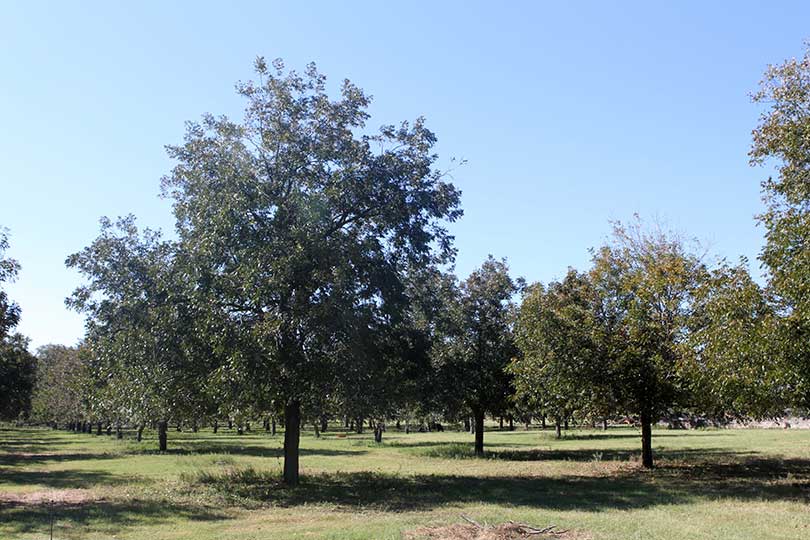The walnut caterpillar has been spotted on some pecan trees in Central and South Texas this fall.
Bald spots on trees are a good indication of walnut caterpillars in a pecan orchard. They prefer mature foliage unlike early season caterpillars that feed on new growth. They feed on leaves of pecan, hickory and walnut trees.
The caterpillars’ bright white eggs are laid next to each other. After the larvae hatch, they feed in a group for several days. They feed on the leaf surface, and older larvae consume the entire leaf, according to the Texas A&M AgriLife Extension Service.
If the tree has several egg clusters, more defoliation can be expected, according to experts.
There has been an increased number of reports of pecan trees suddenly being denuded in Central and South Texas.
“They typically hit our region in the fall and are capable of defoliating whole trees,” Dr. Charles Allen, Texas A&M AgriLife Extension Service entomologist, told AgriLife Today.
Symptoms to watch for include: localized areas of skeletonized leaves, colonies of reddish-brown larvae, foliage loss from larvae feeding, masses of cast skins on the tree truck or main scaffold limbs and fecal material on sidewalks, driveways, equipment and ground.
The impact the caterpillars have on the trees during the fall season may not be as significant, because the leaves become less functional and begin to fall before long.
“Caterpillar damage is mostly an issue of aesthetics at this point because the pecan crop is pretty much made,” he said. “At this time of year, the leaves are producing food that goes back to the roots where it’s stored and will be used next spring to push the buds and make the leaves.”
Allen says as we go further into fall, homeowners may not need to do anything to control them.
“Major defoliation is always a concern, but depending on the time of the year, it may not be a problem for the tree,” Allen said. “Before you risk falling off your roof trying to spray the culprits, remember we’re getting to the point where it may not be as big an issue as it looks.”
Allen recommends waiting until caterpillars move further down the tree as they mature for those wanting to treat them. This will simplify the spraying process.
The 2016 pecan crop is looking pretty good, according to Dr. Larry Stein, AgriLife Extension horticulturist. The pecan is native to Texas and is the official state tree. It can be grown in every area of the state and it is a part of Texas tradition.
Allen said there are some orchards that don’t have much of a crop, but some orchards are faring well.
“It looks like the places that do have pecans though, the crop is getting a little bigger,” Stein said. “It’s on a hit and miss. Some places have a really good crop this year, while other places are not so hot,” Stein said in an interview with the Texas Farm Bureau Radio Network.
According to Stein, some areas have seen scab in their orchards due to the heavy rains.
“We’ve had so much rain, that we’ve had scab,” Stein said. “Scab is a disease, and it starts out as black specks on the nut. It will suddenly engross the entire nut. So we have a lot of scab issues. The good news is we were wet early and then we had the dry period. That arrested the scab.”
He said that demand and pecan prices are high, benefiting growers.
“Prices should be strong for the grower this year,” Stein said. “We think people in the U.S. have figured out that pecans are good and they’re also good for you. There’s a lot of health benefits associated with eating fresh pecans every day. So we’re hopeful that people have figured that out and are going to continue to consume them.”


I planted a tiny pecan tree about 8 years ago. This first year I have seen any leaves being eaten. I don’t have an orchard! I love this tree because it is beautiful! This article helps. I hope mine is same problem? Thanks
Contact your AgriLife Extension agent. They can help you with issues regarding your pecan tree. Thanks for reading!
What is recommended to feed pecan tree?